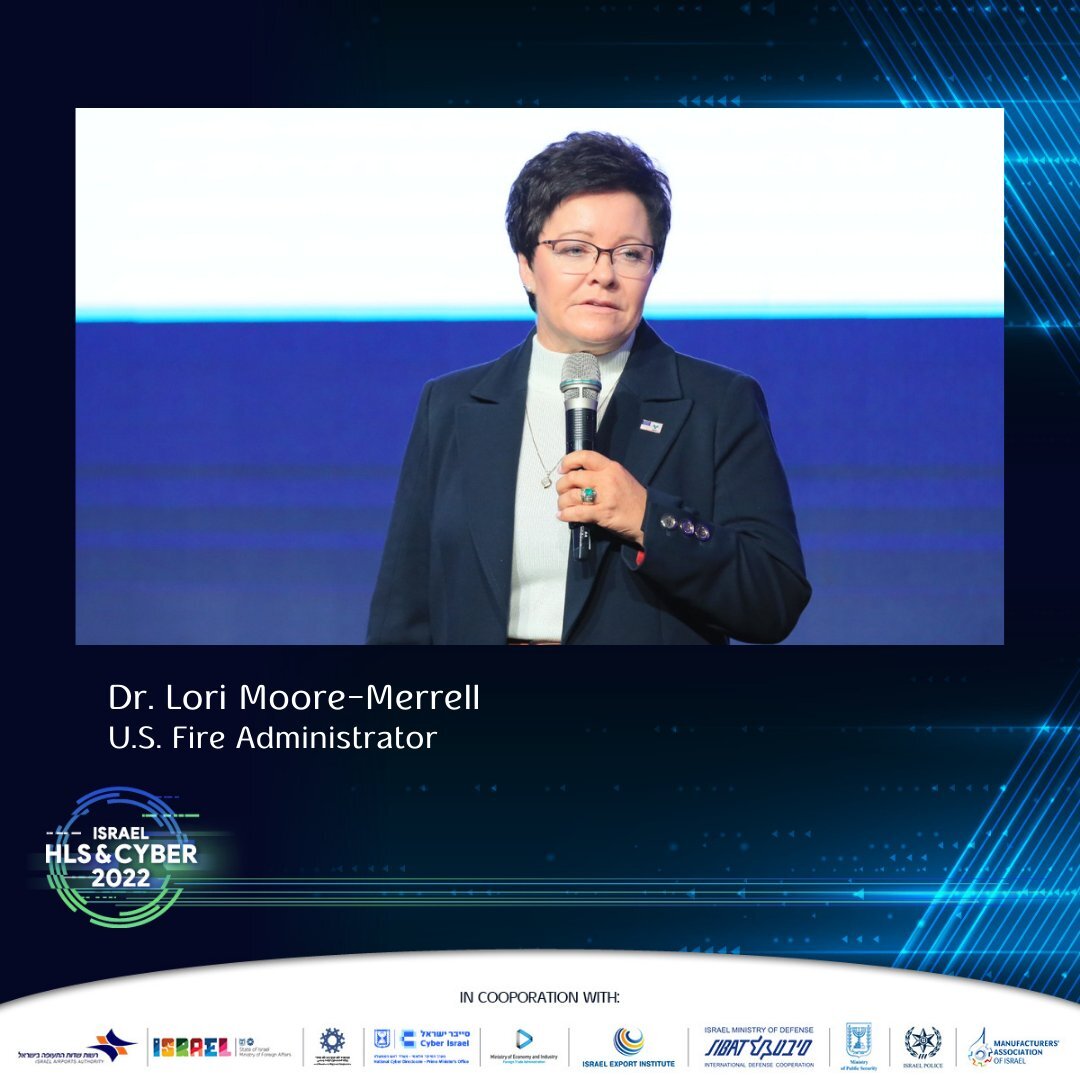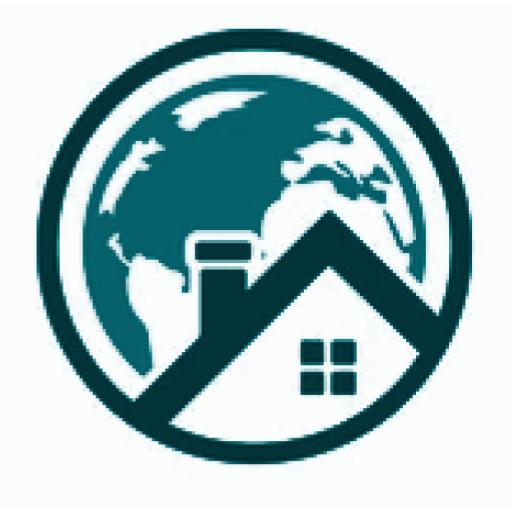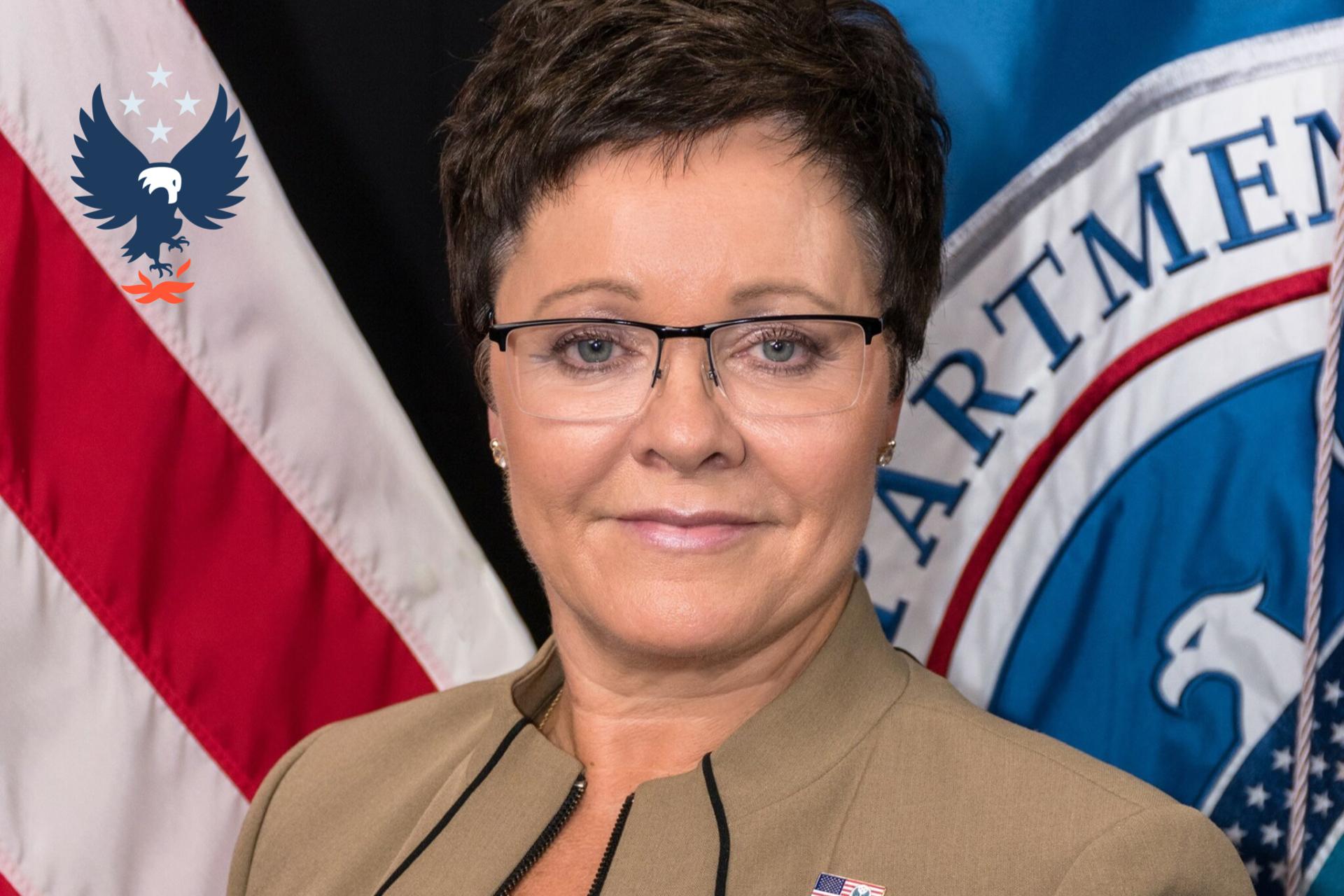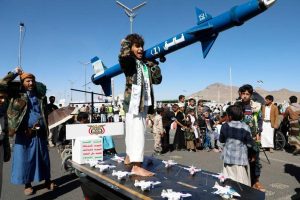Transcript from Israel HLS & Cyber 2022 Speaker: USFA U.S. Fire Administrator Dr. Lori Moore-Merrell
HLS.Today – Thank you so much, good afternoon. I’m so thrilled to be with you today. I will share with you just a little bit about who we are, and what part we play in homeland security. We do reside in homeland security within the US Federal Government, and we have a mission, we actually sit right in our Federal Emergency Management Association agency.
Within FEMA we share the mission response to disaster. But we have a parallel Mission as well and that is to make sure that our First Responders are prepared and strengthened and supported to respond before our federal agencies respond. It’s therefore important to us that we have a resilient and prepared fire, service fire, and Emergency Medical Services. You see in the US the Emergency Medical Services is part of the fire service as well.

So we have four stars in our logo or in our symbol that represents our mission and our four stars are:
- Fire and EMS Training
- Research
- National Fire Data Center
- Community Risk Reduction
Training: We are training our firefighters and EMS personnel, we also do a lot of research, we deal with data as well, and also Community risk reduction and that’s where we get into a lot of risk assessment particularly in the areas of fire threat. So with that I’ll tell you that we still have a fire problem in the US. We still have a lot of fire deaths in the US that might surprise you. But within our country we still have a built environment that lends itself to burning. So with that just this year we are proceeding and even by the end of the week we will have passed 2000 deaths in the US related to fire. So we still have a very real fire threat within our nation. With that we still have structures that burn. This year we’ve had two large multiple fatality fires. One in The Bronx, New York where 17 people died.
The fire was started by a space heater and these fires generally happen in our more impoverished areas, because of the infrastructure and the lack of inadequate housing in many places in the US. So this fire started by a space heater, spreading smoke throughout the building, no one that died in this fire died from the fire itself but from the smoke as it moved through the building. So our infrastructures as I said often are limited and the threat of fire is still very real in the US.
Part of that is that we’re using a lot of low technology. I know this is a technology conference, and we use a lot of low technology, still, as I refer to as low-tech, which is our smoke alarms, and automatic closing doors. Many of the structure pieces that you may already have in the lot of your nations and our built environment we still see if the challenge often especially in our poor communities.

With that we are working very hard with codes and standards. I know here in Israel you do very well with your building codes. When we look at your built environment a lot of masonry is the way that you have fortified and made fire resistant materials for your buildings. In the US we are still challenged with this we still build infrastructure unfortunately that is not fire resistant. So we are moving very aggressively to initiate and enforce codes and standards particularly in our built environment. As some of you may be doing and your countries as well.
Lithium-ion batteries in Electric Vehicles Weaponized
We have another fire threat, when we talked about the threat to Homeland Security. Another very real threat for us are Lithium-ion batteries and micro Mobility products.
How many of you have those in your nations? We have the scooters, we see them even here on the street, to where we have these electric vehicles that have become threats to our very infrastructure. In particular I can tell you in New York we’ve had over two hundred fires recently based on these types of products.
Where the Lithium-ion batteries were the originating factor, the item first ignited and they went into thermal runaway and we still don’t quite understand when and why many of these batteries are going into this thermal runaway and it’s very difficult to suppress them.
So we have major fires that are started by these types of products. When these fires occur as I said our suppression activity is not yet completely understood. So we have other infrastructure that we’re building, energy storage systems, so it’s not just the micro mobility products, not just the hoverboards, or the scooters, or the electric bikes, but also major infrastructure that’s being built for energy storage.
We have a lot of energy storage systems, particularly electric vehicle type batteries that are stacked for energy storage, and these ignite often unexpectedly. So having these ignitions again having the fire service that is prepared to respond to these innovations in technology, it is important. So I know we want to develop the technology that helped us with Homeland Security but we have to understand that many times innovation that we don’t quite understand yet can be a threat to us as well. So we want to look at technology from both sides of that picture. Electric vehicle batteries, and electric Lithium-ion batteries that are used as storage facilities are definitely a fire threat and we’re still seeking to understand.
The other writers’ laboratories in the US and maybe you know them are Global, their research group that is very much into studying the lithium-ion battery problem and looking at electric vehicles.
If any of you have followed hurricane Ian recently in the US that hit the State of Florida then you might have seen in the news how many hundreds of vehicles, electric vehicles that have been submerged in saltwater or affected by salt water, and spontaneously were on fire.
So it’s that we’re trying to understand what has happened now for those of you in law enforcement. Why does this matter to you? Because even now in the states we are starting to try to understand can these electric vehicles be weaponized because of the Lithium-ion batteries.
This is not just about fire and fire suppression, it also has the capability to other uses that we should all be aware of. We have Underwriters Laboratory was looking at the explosive nature of these batteries once they go into thermal runaway what is the deflagration that can occur from these batteries that can cause him to be a bigger threat. Another threat that we are all experiencing, I think globally is wildfire and what we need to understand about Wildfire due to climate change because this has become a global problem.
As we look at Wildfire in trying to understand, when it’s going to happen, because it’s not an if anymore, it’s a when. We have to understand the climate change that is driving that, so we look to our National Oceanic and Atmospheric Agency to tell us about the predictions in nature and this is another place where data can tell us and inform us.
So NOAA, as we call it, tracks the intense Heat. We look at the drought, we look at the reduced humidity and we try to understand what burned in the past and what will burn going forward. So we have very much this kind of threat in our infrastructure. These cascading events, what does it matter that we have wildfire in the forest areas. Well wildfire in the forest areas as long as it remains in the forested area, it’s not that much of a problem.
In fact it burned that way for hundreds of years. But when it reaches the build environment is when we have the problem, where people live and that’s the real threat to our homeland security, because what does that do it does affect our economy, it affects our people, it affects the damage to our very ecosystems, we are watching as our water infrastructure is reduced, across the US and across the globe. Wildfire is a threat to all of our homelands.
The Interface.
Wildfire, not just wildland fire, and this is a distinction that we make in the US, because again if it’s in the wild land or in the forested areas, it’s okay that that burns on occasion, in fact some of our forests thrive on fire. It’s when we extend our communities into areas that were forested, and we extend and we build communities in areas that used to burn, and now we have to look at Wildfire as a threat. So we make a distinction between Wildland fire and wildfire in our communities that we called the Interface. The interface if you hear that word. This is the built environment.
Israel FireDome
Now technology that’s going to make a difference in this space, what do we need? What are we working on and I heard mention already today, FireDome here in Israel.
This is a fantastic problem to be able to work toward FireDome in something that will give us sensors to be able to get to early ignition because the key with fire is that we get to the ignition quickly, if we can get as close to ignition as we can before the fire spreads, then we can extinguish it much more quickly it is moving beyond and when he goes beyond that point of ignition that becomes problematic.
So we have colleagues here today with us from our Homeland Security Science and Technology we’re here to work with Israel on FireDome.
We’re working on sensors. We are testing sensors to sense particulate matter, to sense smoke, to understand when we have an ignition and try to determine if it is good fire or bad fire. Because there are still incidences of good fire, and we need to use good fire to prevent the bad fire. It’s that kind of distinction in building this kind of Technology that’s going to be key.
We also want to make sure that we understand our firefighter gear and our protective equipment for firefighters. Because firefighters, one of the things that you might not know is one of the number one killers of firefighters globally not just in the US but certainly in the US is cancer. It’s not the immediate threat response as much as it is the long-term exposure, we want to be aware of that kind of attention for firefighters as well.
So in our Homeland Security Science and Technology Group they are working very hard to develop these sensors for thermal imaging, these photoelectric sensors, so that we can sense fire closer to the point of origin, closer to the point of ignition, so that we can intervene quickly. So with these sensors, it is going to be key for us going forward, and for Israel certainly is part of the FireDome project.
Climate Change
We also we’re working with our Environmental Protection Agency within the US, we have a Clean Air Act in the US, so we try to reduce smoke in the emissions of vehicles and all of us were two things, which is great, except that when it comes to fighting Wildfire we often have to use fire to fight fire, that means that we do something called prescribed burning, where we burn in the underbrush in order to prevent it from being a fuel in a much larger fire. When we do that it produces smoke, this smoke has much lower exposure capability than having a wildfire that burns a lot of other material.
So we try to teach that to our communities and this is one of the struggles that we have in the US is to help our communities understand that often we have to have good smoke in order to avoid the much more deadly bad smoke of large wildfires. And so we’re working on sensors and trying to understand how we move and prescribed fire.
Now we talked a lot about data already this morning so I will tell you that our White House just in the last couple of months has released a new climate mapping for resilience. I love that word resilience and heard a couple of people use it already. If we can build resilience and we can Harden ourselves to understand and to prevent these events from happening that’s the key regardless we were talking about crime we’re talking about fire. Resilience matters and so we’re looking at being able to have this portal so that it goes not just to our responders but to the communities to individuals in the community so that you can understand the threat to where they live, and that climate change brings the threat of fire and that’s red of fire they can help build resilience. And so this portal is something that they can go in and put it in their community name and it will bring up the information in this is all using Ai and Predictive Analytics.
To be able to tell us what you can anticipate in your community from a fire perspective. These kinds of data projects that we have their ongoing in the US looking at all kinds of Technology, within FEMA are Federal Emergency Management agency which you have technology capabilities not the least of which is tracking the wildfires from a geospatial understanding knowing where they are the size of them but also our early-warning system for evacuation so there we can do math skill alert weather it is for Hurricane for storms for flooding or for fire. So our IPAWS system we are very proud of continues to build that and be able to push it out to our mobile and cellular environment. A shot of some of the tracking that we can do, our geospatial environment understanding the fire environment, and the scale and scope of the fires that are active at any given time. So that understanding helps us understand what we have to pre deploy from a firefighter perspective.
WiFire
Because I said you would say that we deployed firefighters early, to get it close to that point of origin, will if we know fires are likely to run together to become a much larger fire than we can pre deploy resources to try to cut those fires off. So understanding where they are and the scale of a fire help us understand the resources that must be deployed to suppress that fire. We also engage your academic Community. We have something called Wifire and Wifire was developed out of San Diego and it is where we engage align has deployed weather cameras.
In the last presentation there are a lot of cameras deployed in all of our nation’s today right, it’s all those cameras that become a source of data. They become a source of intelligence if they are coupled with other data. It’s always when we lay our data that we have intelligence to tell us about fire when the potential is and again when we can find and identify early ignition so that we can intervene quickly. In the US we have a lot of collaboration, another word that’s been used here today. A lot of collaboration amongst our federal partners. We have three main initiatives that are ongoing in the wildfire space.
One of which is our interagency working group, that’s all of our federal Partners, from interior to agriculture to our forest service firefighters, and of course FEMA and the USFA. We also have Community Partners where we engage our state and local partners, but the biggest of these is our new Wildfire Commission, the wildfire commission that was put in place under the Biden Administration, and by a law that we call our Infrastructure Law.
This law has brought together and allowed us to select the top 25 experts in the country to discuss wildfire and discuss what we need to do, and we are given 12 months to bring these experts together and to have this collaboration and deliver a report to Congress, so that we can take action on Wildfire as is a threat to our homeland. This commission is a huge piece of what we are doing as far as collaboration within the states.
Part of that commission and what we deliver is called the National Cohesive Strategy, now this strategy has been in development for many years, but we are only now coming into real fruition being able to develop the strategy Nationwide. It has three components and I think these three components can be a great advice to you perhaps in your own country.
Because the three components one is Resilient Landscapes I know I talked to some of the Israeli firefighters and they said we have to do more fuel reduction because fire burns up mountains and if you’ve noticed a lot of Israel is built on mountains.
Well once that fire takes off and it begins to go up the mountain then we have a problem. Reducing the fuel that underbrush early can prevent it and can build resilience in your communities. That resilient landscape that’s what we’re talking about it’s reducing the fuel load to prevent the fire.
Then we have of course our Fire Adapted Communities, it’s building infrastructure that is fire resistant, particularly if you’re going to build infrastructure in areas that have burned historically. So it’s important that we build communities that are fire adapted. In the US we often talked about living with fire, and so we looked at our cultural tribal nations in fact to teach us about living with fire, it’s so fire adapted communities using building codes and understanding how this is making sure that our firefighters are and if they are trained to respond, and that we have enough of them to meet the threat of the environment into which their responding.
One of the things we know about the impact on departments, in the US, is that we are being affected with the scale in the scope of wildfire across our country. Longer Wildfire Seasons greater exposure to our firefighters are deployed for many days in the field fighting wildfires across the country, the behavior health impact, their overall exposure to their health and safety, very concerned about security matter what we talked about having capabilities to suppress fire, water is kind of important right.
So these are the kinds of things we are concerned about. More than 80% of our firefighters are now responding to what we called wildfire. Not just one structure at a time, multiple structures at a time and yet only 40% of them are actually trained and equipped to do so. In our structural environment old are well trained for one structured time you’ve been given a great high-rise High Hazard response. But when we have an entire Community that’s burning it’s a different strategy is it different technology different tactics to respond.
So being able to train them in this space is something that we are still moving forward with. Recently I hosted a roundtable and national roundtable on this very subject, and one of the priorities that came together with all of our fire service, not just our chief officers but our Union, all of our community of fire organizations came together, and they said this is one of our priorities. We must address training. We must address the equipment for our firefighters and make sure that we have an adequate number of firefighters to respond and then we take care of them after their behavior, health, their exposure to their equipment and we make sure that we’re able to care for them.
One of the other resources that I’d like to share with you and this is available to you online, is our interface issues and resolutions. It’s a collaboration between us and our federal Partners in interior and our agricultural Partners to talk about wildfire. and it might be something that is a resource for you and your country as well.
I will wrap up with talking a bit about why we are here and that is the Cyber environment and how it has the capabilities to really address Wildfire as well, particularly as a threat to the Homeland, so we are developing a platform, to be able to better understand all of our fire in America. Not just the Wildfire or that that is occurring in our forested areas but that we still have a current in our communities.
This platform is obviously a new cloud-based platform multiple are analytics geospatial environment artificial intelligence and machine learning models And certainly the Internet of Things. So we are collaborating with our partners and Homeland Security Science and Technology to build such a platform so that we have the intelligence to better understand our core problem and move forward with fixing that. Some other technology that we’re looking into as well augmented reality systems for training, this is important, our firefighters be able to train our augmented and realistic environment.
Also personal accountability system tracking are firefighters when they are in the environment itself in fighting fire. Being able to track them both on the X & Y axis but also vertically on the z-axis as well and understanding their overall well-being while they are deployed.
So I will close with this in saying that we need transformational leadership today all of our threats to our homelands, we have to think beyond what we’ve done in the past, we need a new mindset, new skill-set, new ideas and we have to share of course as has been said all morning our capabilities share best practices share our ideas and collaborate together.
I’ll close with this photo this is a photo for our national Fallen firefighter memorial that is located in our National Emergency Training Center campus in Emmitsburg Maryland It is an assembly of many of our homeland security Personnel at our Memorial it was But that’s not remembering the firefighters not only in our country but in your country who step up and put themselves on the front line as do all of our First Responders in this case so with that on behalf of President Biden and our Secretary of Homeland Alejandro Mayorkas and our FEMA administrator Deanne Criswell Administration I want to thank you for allowing us to share some time with you today thank you very much.
2022-fire-administrators-summit-national-roundtable
HLS.Today Source: USFA.FEMA.GOV USFA.FEMA.GOV USFA.DFEMA.GOV TWITTER TWITTER








